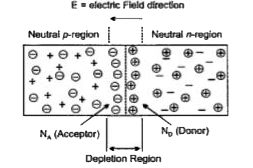With reference to a semi-conductor diode, what is meant by : (i) Forward bias
(ii) Reverse bias
(iii) Depletion region.
(b) An EM wave, Y1, has a wavelength of 1 cm while another EM wave, Y2, has a frequency of 1015 Hz. Name two type of waves and write one application for each.
Depletion region : In a p-n junction, the diffusion of holes and electrons starts initially. Near the junction, holes recombine in n-region to form immobile positive ions. Similarly, electrons recombine in p-region to form immobile negative ions. With sufficient accumulation of such immobile ions on both sides, the diffusion stops. So near the junction, there exists a region in which immobile positive and negative charges reside while mobile charge carriers in this region get completely depleted. This region is called depletion region.

It is a narrow space (region) between p and n regions which does not contain charge carriers (i.e. electrons and holes).
Similar Questions
An electromagnetic wave Y1, has a wavelength 1 cm while other electromagnetic wave Y2 has a frequency of 1015Hz. Name these two types of waves and write one useful application for each.
View SolutionA sound wave has a frequency of 2kHz and wavelength 35cm. How long will it take to travel 1.5km ?
View SolutionA wave travelling along the length of a string is shown in Fig. 14.4.12. Using the scale on the given axis, find
(i) The amplitude of the wave
(ii) The wavelength of the wave
(iii) If the frequency of the wave is 10 Hz, What is the speed of the wave?
(iv) What is the initial phase of the wave ?
(v) What is the phase difference between two points separated by a distance 10 cm ?
(vi) If this wave is made to travel through water what is the wavelength of the wave, if the speed of, the waves in water is 10 m/s.

View SolutionSuppose that the electric field of an electromagnetic wave in vacuum is E={(3.0N/C)cos[1.8rad/m)y+(5.4×106rad/s)t]}ˆi
(a) What is the direction of propagation of wave?
(b) What is the wavelength lambda ?
(c) What is the frequency f ?
(d) What is the amplitude of the magnetic field of the wave
(e) write an expression for the magnetic field of the wave.
View SolutionThe displacement of the medium in a sound wave is given by the equation y1=Acos(ax+bt) where A, aandb are positive constants. The wave is reflected by an obstacle situated at x=0. The intensity of the reflected wave is 0.64 times that of the incident wave.
(a) What are the wavelength and frequency of incident wave?
(b) Write the equation for the reflected wave.
( c ) In the resultant wave formed after reflection, find the maximum and minimum values of the particle speeds in the medium.
(d) Express the resultant wave as a superposition of a standing wave and a travelling wave. What are the positions of the antinodes of the standing wave ? What is the direction of propagation of travelling wave?
View SolutionElectromagnetic waves with wavelength
(i) λ1 is used in satellite communication.
(ii) λ2 used to kill germs in water purifier.
λ used to detect leakage of oil in underground pipelines.
λ4 used to improve visibility in runways during fog and mist conditions.
(a) Identify and name the part of e.m. spectrum to which these radiations belong.
(b) Arrange these wavelengths in ascending order of their magnitude.
(c) Write one more application of each.
View SolutionWhich of the following electromagnetic waves has (a) minimum wavelength, and (b) minimum frequency? Write one use of each of these two waves. Infrared waves, Microwaves, γ and X-rays.
View SolutionA simple harmonic oscillator at the point x=0 genrates a wave on a rope. The oscillator operates at a frequency of 40.0 Hz and with an amplitude of 3.00 cm. the rope has a linear mass density of 50.0g/m and is strectches with a tension of 5.00 N. (a) determine the speed of the wave. (b) find the wavelength. (c ) write the wave function y(x,t) for the wave, Assume that the oscillator has its maximum upward displacement at time t=0. (d) find the maximum transverse acceleration at time t=0. (d) find the maximum transverse of points on the rope. (e) in the discussion of transverse waves in this chapter, the force of gravity was ignored. is that a reasonable assumption for this wave? explain.
View SolutionThe transverse displacement of a string (clamped at its two ends ) is given by
y(x,t)=0.06sin(2π3)xcos(120πt)
wherer x ,y are in m and t ini s. The length of the string is 1.5m and its mass is 3×10−2 kg. Answer the following: (i) Does the function represent a travelling or a stationary wave ?
(ii) Interpret the wave as a superimposition of two waves travelling in opposite directions. What are the wavelength, frequency and speed of propagation of each wave ?
(iii) Determing the tension in the string.
View SolutionThe transvers displacement of a string (clamped at its both ends) is given by
y(x,t)=0.06sin(2π3s)cos(120πt)
Where x and y are in m and t in s. The length of the string 1.5m and its mass is 3.0×10−2kg.
Answer the following :
(a) Does the funcation represent a travelling wave or a stational wave ?
(b) Interpret the wave as a superposition of two waves travelling in opposite directions. What is the wavelength. Frequency and speed of each wave ?
Datermine the tension in the string.
View Solution